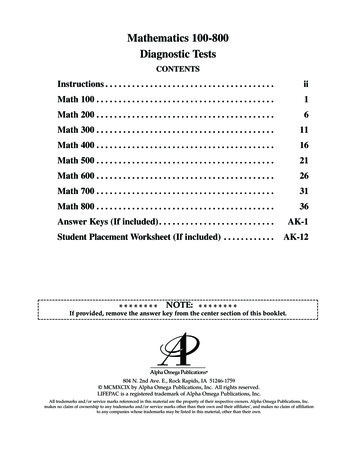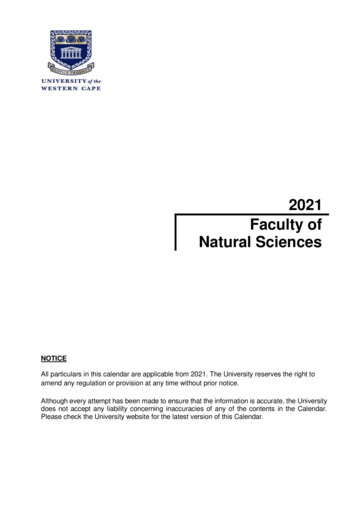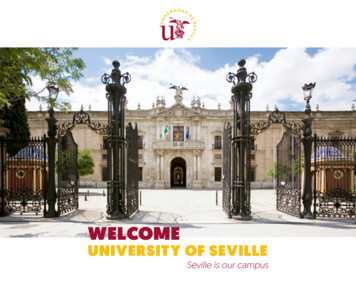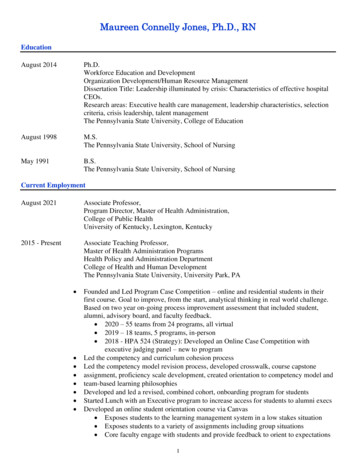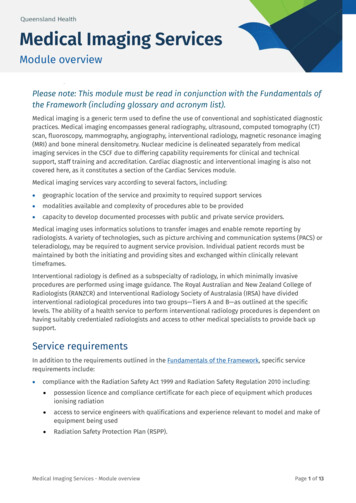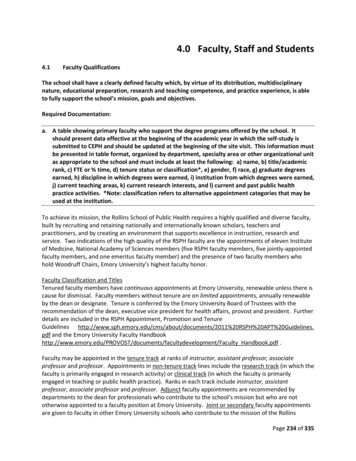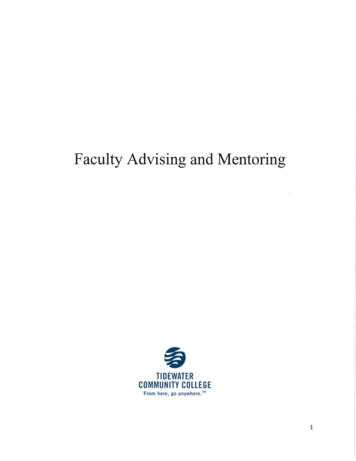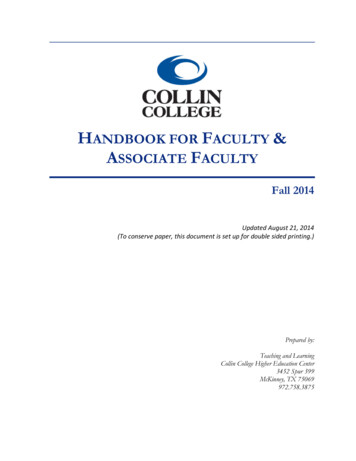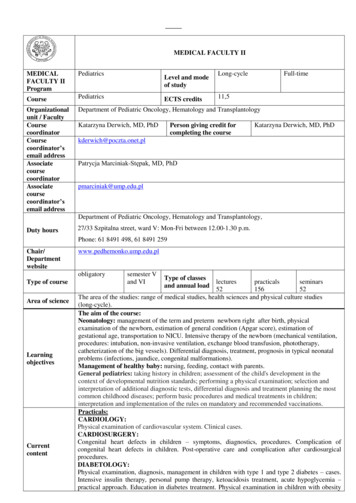
Transcription
MEDICAL FACULTY IIMEDICALFACULTY nit / FacultyCoursecoordinatorCoursecoordinator’semail ordinator’semail addressDepartment of Pediatric Oncology, Hematology and TransplantologyLevel and modeof studyECTS creditsKatarzyna Derwich, MD, PhDLong-cycleFull-time11,5Person giving credit forcompleting the courseKatarzyna Derwich, MD, PhDkderwich@poczta.onet.plPatrycja Marciniak-Stępak, MD, PhDpmarciniak@ump.edu.plDepartment of Pediatric Oncology, Hematology and Transplantology,Duty hours27/33 Szpitalna street, ward V: Mon-Fri between 12.00-1.30 p.m.Phone: 61 8491 498, 61 8491 lobligatoryType of courseArea of scienceLearningobjectivesCurrentcontentsemester Vand VIType of classeslecturespracticalsseminarsand annual load5215652The area of the studies: range of medical studies, health sciences and physical culture studies(long-cycle).The aim of the course:Neonatology: management of the term and preterm newborn right after birth, physicalexamination of the newborn, estimation of general condition (Apgar score), estimation ofgestational age, transportation to NICU. Intensive therapy of the newborn (mechanical ventilation,procedures: intubation, non-invasive ventilation, exchange blood transfusion, phototherapy,catheterization of the big vessels). Differential diagnosis, treatment, prognosis in typical neonatalproblems (infections, jaundice, congenital malformations).Management of healthy baby: nursing, feeding, contact with parents.General pediatrics: taking history in children; assessment of the child's development in thecontext of developmental nutrition standards; performing a physical examination; selection andinterpretation of additional diagnostic tests, differential diagnosis and treatment planning the mostcommon childhood diseases; perform basic procedures and medical treatments in children;interpretation and implementation of the rules on mandatory and recommended vaccinations.Practicals:CARDIOLOGY:Physical examination of cardiovascular system. Clinical cases.CARDIOSURGERY:Congenital heart defects in children – symptoms, diagnostics, procedures. Complication ofcongenital heart defects in children. Post-operative care and complication after cardiosurgicalprocedures.DIABETOLOGY:Physical examination, diagnosis, management in children with type 1 and type 2 diabetes – cases.Intensive insulin therapy, personal pump therapy, ketoacidosis treatment, acute hypoglycemia –practical approach. Education in diabetes treatment. Physical examination in children with obesity
and metabolic syndrome – cases. Acute and chronic complications of hyperglycemia andoverweight – practical aspects (insulin resistance, prediabetes, dyslipidemia, NAFLD, PCOS,arterial hypertension, puberty and growth disorders). Monogenic diabetes and genetic syndromeswith obesity – cases. Continuous glucose monitoring system, body composition evaluation – casesand practical exercises. Congenital hyperinsulinism – diagnosis/clinical presentations/treatmentPEDIATRIC OTOLARYNGOLOGY:Anatomy and physiology of nose, paranasal sinuses, nasopharynx, oral cavity, throat and larynx inchildren. Examination of ear, nose, nasopharynx, oropharynx and larynx in children - maindifferences between children and adults in ENT examination. Presentation of patients treated inENT Dept (diagnostic tools, methods of treatment, indications for surgical treatment, postoperativecare and possible complications). Operating Theatre Classes - the principles of aseptic andantisepsis in the operating room, differences in surgical techniques between adults and children,observation of pediatric ENT surgical procedures. Assessment of hearing impairment in earlychildhood – use of objective hearing tests in evaluation and early treatment of hearing disorders inchildren.ENDOCRINOLOGY:Presentation, diagnostics, differential diagnosis and therapeutic possibilities of the endocrinologicchildhood diseases: hyper and hypothyroidism, autoimmune thyroiditis, nodular goiter, precociousand late puberty, puberty disturbances (e.g. PCOS), disorders of sexual development (DSD), growthdisorders including short and tall stature with the concentration on growth hormone deficiency andTurner syndrome, bone disorders like osteogenesis imperfecta, rickets and osteoporosis, pituitarydisorders. Possibility to perform thyroid ultrasonography.GASTROENTEROLOGY:Presentation, diagnostics, differential diagnosis and therapeutic management of inflammatorybowel diseases, celiac disease, cystic fibrosis ad the most common metabolic disorders in children.INFECTIOUS DISEASES:Clinical examination of a child with infectious disease, presentation of cases, management –exposition and transmission of the diseases, ways of isolation, prophylactic measures,immunoprophylaxis, presentation, diagnostics, differential diagnosis and treatment of infectiousdiseases of childhood: exanthematous diseases, neuroinfections, sepsis, viral and bacterialdiarrhoea, viral hepatitis, congenital infections, infections of animal origin.Essentials of childhood neurology: child development and developmental abnormalities, seizuresand epilepsy, headaches.NEONATOLOGY:Management and resuscitation at birth. Stabilization and transportation. Physical examination.Nursing practice of sick and healthy baby. Respiratory failure, mechanical ventilation, intubation.Enteral and parenteral nutrition. Metabolic problems, infection, heart failure, congenitalmalformations.NEPHROLOGY:Practical aspects of physical examination in a child with kidney diseases. Congenital abnormalitiesof the kidneys and urinary tract – pathogenesis/treatment/cases. Glomerulonephritis –pathogenesis/treatment/cases. Hypertension – pathogenesis/treatment/cases. Acute and chronicrenal failure– pathogenesis/treatment/cases. Intoxications in children. Blood purification.ONCOLOGY AND HEMATOLOGY:Presentation, diagnostics, differential diagnosis and therapeutic management of hematologic(anaemias, bleeding disorders, bone marrow failure) and oncologic diseases (hematologicneoplasms and solid tumors) in children. Basic aspects of haematopoietic stem cellstransplantations (HSCT) in children. Acute and long term side effects of oncological treatment inchildren and adolescents. Supportive care in paediatric hemato-oncology.RHEUMATOLOGY:Presentation, diagnostics, differential diagnosis and therapeutic possibilities of the rheumatologicchildhood diseases. Juvenile idiopathic arthritis, lupus erythematosus, scleroderma, vasculitis.RESPIRATORY DISEASES:Acute infections of the respiratory system in children: acute bronchitis, community- and hospitalacquired pneumonia, necrotizing pneumonia, lung abscess, pleural effusion, pneumothorax.Respiratory manifestation of systemic diseases. Respiratory diseases in infancy: congenitalmalformation, bronchopulmonary dysplasia, acute viral bronchiolitis, recurrent wheezing.Inhalation therapy: aerosol delivery devices, inhaled drugs, choice of therapy, adherence to therapy.Childhood asthma and allergic diseases: asthma exacerbation – symptoms, severity, management;anaphylaxis, allergic rhinitis, atopic dermatitis, food allergy – epidemiology, symptoms, diagnostic
procedures, triggers, management, allergen specific immunotherapy. Chronic diseases of therespiratory tract: cystic fibrosis, chronic bronchitis, primary ciliary dyskinesia, interstitial lungdiseases. Spirometry: basic, reversibility and exercise testing.SURGERY: Practical aspects of physical examination in a child with surgical diseases and trauma.Practical aspects of wound dressings changing. Techniques of surgical suturing (single, mattress,continuous sutures) and removing sutures. Techniques of immobilization of extremities andremoving of immobilization. Observation of surgical procedures in operating theatreSeminarsCARDIOLOGY: Inflammatory diseases of the heart - Dr Emilia Szafran; Congenital heart defect cyanotic and non-cyanotic - Dr Paulina Walasek; Pediatric ecg tutorial- Dr Agnieszka PurolCARDIOSURGERY:DIABETOLOGY: Type 1 diabetes in children and adolescents - Prof. P. FichnaPEDIATRIC OTOLARYNGOLOGY: The most common diseases of oropharynx, nasopharynx,salivary glands in children. Acute respiratory distress in children. Foreign bodies of respiratory tractand esophagus in children – symptoms, diagnosis and treatment - Doc. J. Szydłowski/Dr M.Kotowski/Dr M.Prauzińska; Symptoms, signs and investigations of nose and paranasal sinusesdiseases in children. Symptoms, signs and investigations of ear diseases in children - Dr B.Pucher/Dr J. SroczyńskiENDOCRINOLOGY/RHEUMATOLOGY: Growth disorders - Dr M. Obara-Moszyńska,Clinical manifestations of connective tissue diseases - Dr E.Pawlaczyk-Wróblewska, Clinical casepresentations - Dr Z.Kolesińska, Juvenile idiopathic arthritis - Dr E.Pawlaczyk-WróblewskaGASTROENTEROLOGY: Cystic fibrosis. Abdominal pain - diagnostic and therapeuticapproach.INFECTIOUS DISEASES: Seminars: Infections of the central nervous system - Doc K. MazurMelewska; Viral hepatitis in children - Doc. A. ManiaNEONATOLOGY: Neonatal jaundice - Dr Różycka, Surfactant therapy - Dr Adamczak,Resuscitation of the newborn - Dr Neumann, Perinatal infections - Dr RóżyckaNEPHROLOGY: Pathogenesis of damage glomerulonephritis - Prof. J. Zachwieja; Nephrologicalcases uncovered - Prof. D.Ostalska-NowickaONCOLOGY AND HEMATOLOGY: Anemias in children. Bleeding disorders - Dr J. SkalskaSadowska; Leukemias and lymphomas - Doc. K. Derwich; Solid tumors - Prof. D. JanuszkiewiczLewandowska; Haematopoietic stem cells transplantations (HSCT) in children - prof. J.WachowiakRESPIRATORY DISEASES: Allergic diseases in children - Dr P.Sobkowiak, Pneumonia inimmunocompromised children - Doc A.Szczawińska-Popłonyk, Chronic diseases of the RT - DrI.Wojsyk-Banaszak, Acute bronchiolitis. Differential diagnosis of recurrent and persistentrespiratory symptoms in children - Dr A.ŚwiatłySURGERY: Paediatric Urology, Neurosurgery: Dr B. Kocąb, General Paediatric Surgery,Newborn Surgery: Dr M. Rzanny-OwczarzakLectures:CARDIOLOGY: Congenital heart diseases- Dr P.Walasek, Arrythmias-Dr A.Łaźniak,Inflammatory diseases of the heart-Dr M.BarteckiCARDIOSURGERY:DIABETOLOGY: Childhood obesity – Dr B.SkowrońskaPEDIATRIC OTOLARYNGOLOGY: Basic issues in pediatric otolaryngology - Doc.Szydłowski/ Dr B.Pucher/ Dr J.Sroczyński/ Dr M. Kotowski/ Dr M.PrauzińskaENDOCRINOLOGY: Thyroid disorders - Prof. M.Niedziela, Endocrine late effects of childhoodcancer therapy - Prof. M.Niedziela, Sexual development and pubertal disorders - Prof. M.NiedzielaGASTROENTEROLOGY: Chronic diarrhea in children. Metabolic disorders in children.INFECTIOUS DISEASES: Prevention, diagnostics and treatment of congenital infections - Doc.K. Mazur Melewska; Exantomatous infectious diseases in childhood - Doc. A. Mania.;NEONATOLOGY: Adaptation to extrauterine life - Dr Pieczara, Complications of prematurity Dr Burchardt-Kroll, Respiratory disorders and ventilation support - Dr Szczapa, Pathology of CNSin newborn period - Dr SzpechtNEPHROLOGY: Symptoms and signs of renal tract and kidney diseases in children - Prof. J.Zachwieja; Urinary tract infection in children - Prof. Ostalska-Nowicka
ONCOLOGY AND HEMATOLOGY: Case presentations - Doc K.DerwichRHEUMATOLOGY: RESPIRATORY DISEASES: Pneumonia in children - Doc A.Szczawińska-Popłonyk, Childhoodasthma - Dr P.Sobkowiak, Cystic fibrosis and chronic diseases of the respiratory tract - DrI.Wojsyk-BanaszakSURGERY: Paediatric Urology - Prof. A. Jankowski, General Paediatric Surgery - Dr J.Noskiewicz, Dr M. Rzanny-OwczarzakClasses’ location: pediatric and pediatric surgery course: Children’s Hospital (27/33 Szpitalna st.),lectures: first floor (room 116, auditorium) and seminars: groundfloor (rooms 1A, 41) - accordingto the schedule; neonatology course: Department of Neonatology (33 Polna st.).The course will last from 2017 (group B) and 2018 (group A) and will be divided into blocksaccording to the schedule.Based on the list of students from the Dean’s Office, whole 4 MD Program will be divided intogroup A and B, and then students will be divided consecutively into subgroups each containing 5-6students.The program is divided into obligatory sessions - an attendance is necessary to pass the course!There will be 52 hours of lectures, 52 hours of seminars and 156 hours of practical exercises. At thebeginning of the course there will be lectures obligatory for whole students (presence will beverified). Every day there will be obligatory practical exercises in the ward or out-patient clinic (4hrs) and seminars (2-4 hrs). During seminars, on the basis of clinical cases, students are expectedto present their theoretical knowledge. During exercises on the wards and in out-patient clinics,students are expected to train and improve practical aspects of pediatrics.Course starts at 8 a.m. - please be on time! Late-coming is not accepted! 2 delays of 15 minsequals one day of absence.Course details(including typeof classes,classes’ datesand locations,teachingassistants,topics coveredduring classes)During whole pediatric course 2 absences are permitted.There is nominated representative of each Department, who is responsible for each block of topics in case of any problem you should contact:CARDIOLOGY: Prof. Waldemar Bobkowski, MD, PhD (wbobk@mp.pl)CARDIOSURGERY: Rafał Bartkowski, MD, PhD (rpbartkowski@gmail.com)DIABETOLOGY: Bogda Skowrońska, MD, PhD (bskowron@ump.edu.pl)PEDIATRIC OTOLARYNGOLOGY: Beata Pucher, MD, PhD (bpucher@poczta.onet.pl)ENDOCRINOLOGY/ RHEUMATOLOGY: Monika Obara-Moszyńska, MD, PhD(mmoszynska@ump.edu.pl)GASTROENTEROLOGY: Beata Klincewicz, MD, PhD (bklincewicz@vp.pl)INFECTIOUS DISEASES: Anna Mania, MD, PhD (amania@ump.edu.pl)NEONATOLOGY: Ewa Burchardt-Kroll, MD, PhD (ewakroll@ump.edu.pl)NEPHROLOGY: Prof. Jacek Zachwieja (zachwiej@mp.pl)ONCOLOGY AND HEMATOLOGY: Katarzyna Derwich, MD, PhD(kderwich@poczta.onet.pl)RESPIRATORY DISEASES: Aleksandra Szczawińska-Popłonyk, MD, PhD(ola@malwa.com.pl, aszczawinska@ump.edu.pl)SURGERY: Małgorzata Rzanny-Owczarzak, MD (malgorzata.rzanny@gmail.com)Teaching assistants:CARDIOLOGY (ward IV/VI): Dr P.Walasek, Dr A.Łaźniak, Dr M.Bartecki, Dr A.Kowalska-Tupko, DrK.Łopusiewicz, Dr W.Pelczar-PłachtaCARDIOSURGERY (ward I): Dr R.BartkowskiDIABETOLOGY (ward XI): Prof. P.Fichna, Dr B.Skowrońska, Dr A.Gertig, Dr E.Niechciał,Dr I. KrzyśkoPEDIATRIC OTOLARYNGOLOGY (ward X): Doc. J. Szydłowski, Dr B. Pucher, Dr J. Sroczyński,Dr M. Prauzińska, Dr M. Kotowski, dr P.Adamczyk, Mgr B. PolskiENDOCRINOLOGY/RHEUMATOLOGY (ward XII): Prof. M.Niedziela, Dr M.Obara-Moszynska,Dr Z. Kolesinska, Dr M. Banaszak-Ziemska, Dr M.Flader, Dr A.Rojek, Dr E.Pawlaczyk-WroblewskaGASTROENTEROLOGY (ward XIII): Prof. J. Walkowiak, Dr B. Klincewicz, Dr Ł. Kałużny,Dr N. Kobelska-Dubiel
INFECTIOUS DISEASES (ward VIII): Prof. W.Służewski, Prof. M.Figlerowicz, Doc. K.MazurMelewska, Doc. A.Mania, Dr K.Kuls, Dr P.Małecki, Dr J.NowakNEONATOLOGY (Dep. of Neonatology, Dep of Delivery and Perinatology): Doc. J.Mazela,Dr T.Szczapa, Dr M.Sierzputowska-Pieczara, Dr E.Burchardt-Kroll, Dr SzpechtNEPHROLOGY (ward IV/VI): Prof J.Zachwieja, Prof D.Nowicka, Dr M.Silska, Dr J.Sołtysiak,Dr A.Blumczyński, Dr A.Musielak, Dr A.NeymanONCOLOGY AND HEMATOLOGY (ward III/V/VD/TSK): Prof. J.Wachowiak, Prof.D.Januszkiewicz-Lewandowska, Doc. K.Derwich, Dr J. Skalska-Sadowska, Dr A.Pieczonka,Dr P.Marciniak-Stępak, Dr O.Zając-Spychała, Dr M.BarełkowskaRESPIRATORY DISEASES (ward VII/XIV): Doc A.Szczawińska-Popłonyk, Doc A.Szczepankiewicz,Dr A.Światły, Dr I.Wojsyk-Banaszak, Dr P.Sobkowiak, Dr L.Ossowska, Dr A.KamińskaSURGERY (ward I/II): Urology: Prof. A.Jankowski, Dr P.Kroll, Dr P.Juszczak; Neurosurgery: DrP.Kopaczewski, Dr K.Strzyżewski, Dr A.Jażdżewska; Newborn Surgery: Doc. M.Błaszczyński, DrP.Sarnowska; General Pediatric Surgery: Doc. P.Mańkowski, Doc. J.Harasymczuk, Dr S.Moryciński,Dr O.Pietkiewicz, Dr M. SawickiTests/examinationdates includingmake-up tests/examinationdates (afterpriorconsultationwith classrepresentative)Forms andmethods ofteachingForms andconditions forreceivingcreditsFINAL WRITTEN EXAM (NBME):To take the final written exam (NBME) student has to pass the whole pediatric course.All students have to take NBME exam at the same time!There will be 4 terms for 4 M.D. and 6 M.D. programs (2 in winter and 2 in summer semester)1. for group B: more details will be given later2. for group A: more details will be given laterIn individual cases test may be postponed - only with the Dean’s permission.Retake exams:Students who have failed the NBME exam will have two retake exams and a final retake exam - ineach semester there will be only one term for first and second retake exams and a final retake exam.Students who have failed all four attempts must repeat the whole course the following academicyear.Grading system for NBME exams (www.nbme.org):- very good (5.0): score 80-100,- better than good (4.5): 75-79,- good (4.0): 70-74,- fairly good (3.5): 65-69,- satisfactory (3.0): 60-64,- failed (2.0): 60.Seminars with a review of basic informationPresentation of management algorithmsAnalysis of clinical casesPresentation of cases on the basis of real patientsPractical exercises and improvement of practical skills (physical examination, taking history,preparing prescription, phantoms)DiscussionTo get the credits from pediatric course student has to:- attend to exercises and seminars: only 2 absences are permitted during whole pediatrics course!;- neonatology: pass a 10 questions tests;- general pediatrics: present a 15 minutes long case about chosen clinical aspect – for the wholesubgroup – “case presentation”- at the end of the course fill in an anonymous questionnaire assessing the course;- get a positive assessment during practicals and seminars from assistants as well as final positiveappraisal from co-ordinator of pediatric course.In some cases student may be expected to prepare some topics (clinical case, presentation, articlereview etc.) to improve his mark from the pediatric course (decision of course co-ordinator).Credit from the course must be obtained until: 15.12.2017 (group B) and 11.05.2018 (group A)Requiredtextbooks- Marcdante KJ et al.: NELSON ESSENTIALS OF PEDIATRICS, Saunders/Elsevier 2011- Marino BS et al.: BLUEPRINTS PEDIATRICS, 6th edition, Wolters Kluwer/ Lippincott Williams&Wilkins 2013- Klaus&Fanaroff's: CARE OF THE HIGH-RISK NEONATE, Elsevier/Saunders 2013- Lawrence PF et al.: ESSENTIALS OF GENERAL SURGERY, 5th edition, Wolters Kluwer/
Lippincott Williams& Wilkins 2013Recommendedtextbooks- Kliegman R et al.: NELSON TEXTBOOK OF PEDIATRICS, 19th edition, Saunders/Elsevier 2011- Hull D et al.: ESSENTIAL PAEDIATRICS, 4th edition, Churchill Livingstone- Milner AD et al.: HOSPITAL PAEDIATRICS, Churchill Livingstone- Shelov SP: CARING FOR YOUR BABY AND YOUNG CHILD: BIRTH TO AGE 5, AmericanAcademy of Pediatrics, 2009- Licameli G.R., Tunkel D.E.: PEDIATRIC OTORHINOLARYNGOLOGY: DIAGNOSIS ANDTREATMENT, Thieme 2013Handouts- Hand-outs may be prepared by assistants depending on topics of seminars and given studentsduring the courseCourseregulationsTo get the credits from pediatric course student has to:- attend to exercises and seminars: only 2 absences are permitted during whole pediatrics course!;- neonatology: pass a 10 questions tests;- general pediatrics: present a 15 minutes long case about chosen clinical aspect – the wholesubgroups only once;- at the end of the course fill in an anonymous questionnaire assessing the course;- get a positive assessment during practical classes and seminars from assistants as well as finalpositive appraisal from co-ordinator of pediatric course.Late-coming is not accepted! 2 delays of 15 mins equals one day of absence. During wholepediatric course 2 absences are permitted.Symbol oflearningoutcomeLearning outcomesReference toprogram learningoutcomesGraduates have the knowledge which enables them to:E.W01.E.W02.E.W03.E.W04.E.W05.know environmental and epidemiological conditions of most common diseases;E.W1.E.W2.know the nutrition principles for healthy and sick children, the principles ofimmunization and keeping children's medical records;E.W3.know and understand the causes, symptoms, principles of diagnosis andchildhooddiseases:therapeutic treatment of most commona) rickets, tetany, convulsions,b) heart defects, myocarditis, endocarditis and pericarditis, cardiomyopathy,arrhythmias, heart failure, high blood pressure, syncope,c) acute and chronic diseases of the upper and lower respiratory tract, congenitaldefects of the respiratory system, tuberculosis, cystic fibrosis, asthma, allergicrhinitis, urticaria, anaphylaxis, angioedema,d) anaemia, bleeding disorders, bone marrow failures, paediatric cancers,including typical childhood solid tumours,e) acute and chronic abdominal pain, vomiting, diarrhoea, constipation,gastrointestinal bleeding, peptic ulcer disease, non-specific bowel diseases,pancreatic disease, cholestasis and liver diseases and other acquired diseases andcongenital defects of the gastrointestinal tract,f) urinary tract infections, congenital anomalies of the urinary tract, nephroticsyndrome, kidney stones, acute and chronic renal failure, acute and chronicinflammation of the kidneys, kidney systemic diseases, urination disorders,vesicoureteral reflux,g) growth disorders, diseases of the thyroid and parathyroid, adrenal diseases,diabetes, obesity, disorders of pubertal development and male and female gonadalfunctions,h) cerebral palsy, encephalitis and meningitis, epilepsy,i) most common childhood infectious diseases,j) genetic syndromes,k) connective tissue diseases, rheumatic fever, juvenile arthritis, systemic lupus,dermatomyositis;E.W5.know the basic diagnostics and treatment of the foetus;E.W6.know the most common life-threatening conditions in children and the rules ofconduct in such conditions;
E.W06.know the environmental and epidemiological conditions of most commonneoplasms in children;E.W23.E.W07.know the basis of early detection of cancer and the principles of screening inpediatric oncology;know the possibilities of modern cancer therapy (including multimodal therapy),the prospects of cell and gene therapy and its adverse effects;E.W24.E.W08.E.W09.E.W10.E.W25.E.W26.know the rules of combination therapies in oncology, diagnostic and therapeuticalgorithms in most common human neoplasms in children;know and understand the causes, symptoms, diagnosis and principles ofE.W32.therapeutic and prophylactic procedures in most common bacterial, viral, parasiticand fungal infections, including pneumococcal infections, viral hepatitis, acquiredimmunodeficiency syndrome AIDS, sepsis and hospital infections;Graduates have the skills which allow them .U17.E.U18.E.U19.E.U20.E.U21.E.U22.conduct a medical interview with a child and the child's family;perform a complete physical examination of a child at any age;perform basic hearing test and visual field test, as well as otoscopic exam;assess the general condition, consciousness and awareness of the patient;assess a newborn infant on the Apgar scale and assess its maturity and neonatalreflexes;compare anthropometric and blood pressure measurements with the data in thegrowth chartassess the progress of puberty;provide well-child care;make a differential diagnosis of most common diseases in children;evaluate and describe the patient's somatic and mental state;recognize conditions that are a direct threat to life;plan diagnostic, therapeutic and preventive procedures;analyze potential adverse reactions of particular drugs and interactions betweenthem;suggest individual approach to the existing therapeutic guidelines and othertreatment methods in case of ineffectiveness or contraindications to standardtherapy;qualify the patient for domestic and hospital treatment;define conditions in which life expectancy, functional condition or patient'spreferences limit the procedures that are consistent with the guidelines for thedisease;interpret laboratory tests and identify the reasons for deviations;use nutritional therapy (including enteral and parenteral nutrition);plan the actions to be taken in case of exposure to blood-borne pathogens;qualify patients for immunization;perform basic medical procedures and treatments, including:a) body temperature measurement, heart rate measurement, non-invasive bloodpressure measurement,b) monitoring of vital signs using a cardio-monitor, pulse oximetry,c) spirometry, oxygen therapy, assisted and alternative ventilation,d) intravenous, intramuscular and subcutaneous injections, cannulation ofperipheral veins, collection of: peripheral venous blood, blood cultures, arterialblood and arterialized capillary blood,e) collecting smear samples from the nose, throat and skinf) catheterization of the bladder in men and women, gastric intubation,g) standard ECG with interpretation,h) simple strip tests and measuring the concentration of glucose in the blood;assist with the following procedures and medical treatments:a) transfusion of blood preparations and blood products,b) drainage of the pleural cavity,c) pericardiocenteseis,d) lumbar puncture,e) epidermal tests 25.E.U26.E.U27.E.U29.E.U30.
E.U23.f) intradermal and chamber scarification tests and interpret the results;interpret the pharmaceutical characteristics of medicinal products and criticallyassess advertising materials relating to drugs;E. U31.E.U24.E.U25.plan specialist consultations;perform proper procedures in case of injuries (put dressing or use immobilization,dress and suture the ecognize the agony of the patient and declare death;keep the medical records of the 33.E.U34.E.U35.E.U36.E.U37.E.U38.apply the principles of asepsis and antisepsis;dress simple wounds, put and change sterile surgical dressings;examine nipples, lymph nodes, thyroid and abdominal cavity in terms of acuteabdomen, and perform a rectal examination;assess the results of radiological tests in terms of most common types of fractures,especially fractures of long bones;perform temporary immobilization of the limb, select the type of immobilizationnecessary for use in typical clinical situations and validate the blood supply to thelimb after the immobilization is performed;dress external bleeding;perform basic life support procedures with automated external defibrillator andother emergency procedures and provide first aid;act according to the current advanced life support algorithm;monitor the postoperative period based on basic vital parameters;perform basic laryngologic examination of the ear, nose, throat and larynx;perform basic hearing Graduates have the knowledge which enables them to:E.K01.E.K02.E.K03.Studentworkloadknow the issues related to currently used imaging tests, in particular:a) radiological symptomatology of basic diseases,b) instrumental and imaging techniques used for medical treatments,c) indications, contraindications and preparing patients for various types ofimaging tests and contraindications for the use of contrasting agents;know basic concepts of laryngology, audiology and phoniatrics, including:a) causes, clinical course, treatment, complications and prognosis in diseases ofthe ear, nose, paranasal sinuses, mouth, pharynx and larynx,b) diseases of the facial nerve and certain structures in the neck,c) diagnostic and therapeutic procedures in mechanical injuries of the ear, nose,larynx and oesophagus,d) the rules of conduct in emergency conditions in otorhinolaryngology,particularly in laryngeal dyspnea,e) diagnostic and therapeutic procedures in hearing, voice and speech disorders,know and understand the causes, symptoms, principles of diagnosis andtherapeutic treatment of most common diseases of the central nervous system interms of:a) cerebral oedema and its consequences with particular emphasis on emergencysituations,b) traumatic brain injuries,c) tumours of the central nervous system,d) diseases of the spine and the spinal cord;Contact hours with an academic teacherparticipation in lecturesparticipation in practical classesparticipation in seminarsSelf-directed learningpreparation for practical classespreparation for seminarspreparation for colloquiumspreparation for examinationsOtherE.K01.E.K02.E.K03.Annual load0195653525515
34011.5TotalECTS creditsQuantitativeindicatorsStudent workload related to contact hours with an academic teacherStudent workload related to practical classesHoursECTS2905083.5Methods for assessing student learning outcomesSymbol oflearningoutcomeAllDate ofpreparing thesyllabusFormativeSummative- 10 questions test (neonatology)- discussion during seminars and practical- clinical case presentationclasses- final positive appraisal from co-ordinator of- observation and assessment of students skillspediatric course01.10.2017Katarzyna Derwich, MD, PhD kderwich@poczta.onet.plPerson preparingPatrycja Marciniak-Stępak, MD, PhD pmarciniak@ump.edu.plthe syllabusTel: 61 8491 498, 61 8491 259
MEDICAL FACULTY II MEDICAL FACULTY II Program Pediatrics Level and mode of study Long-cycle Full-time Course Pediatrics ECTS credits 11,5 Organizational unit / Faculty Department of Pediatric Oncology, Hematology and Transplantology

